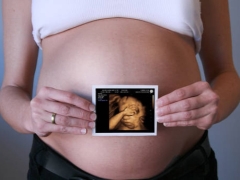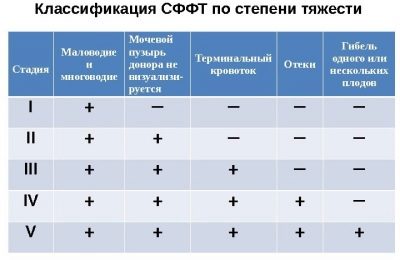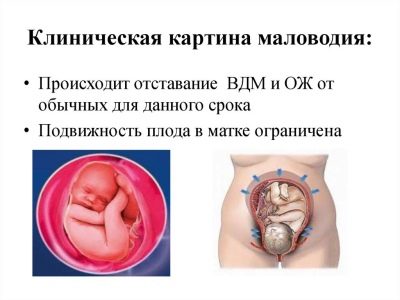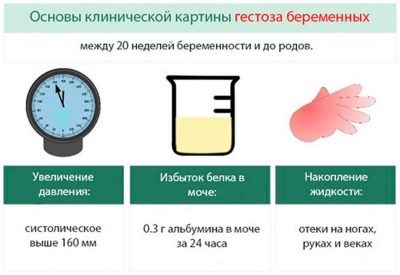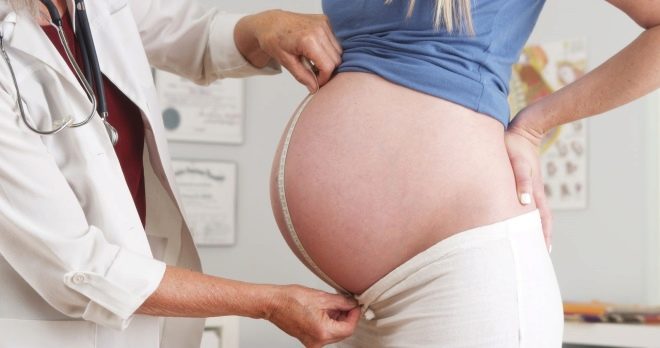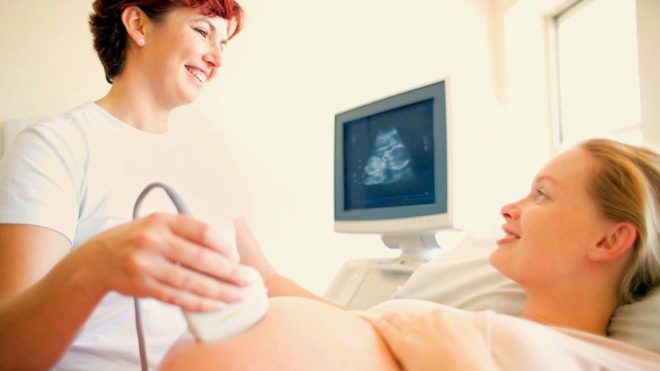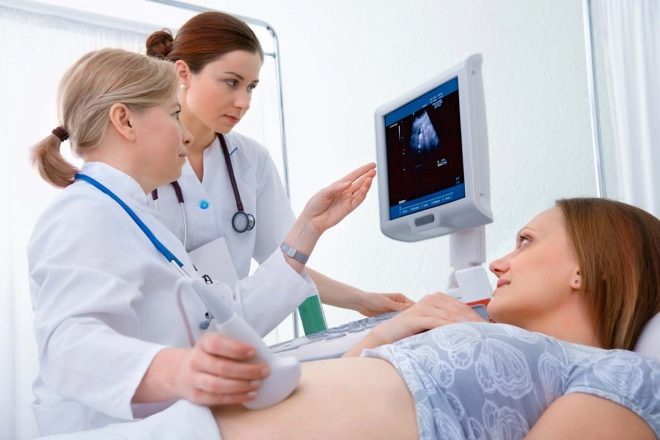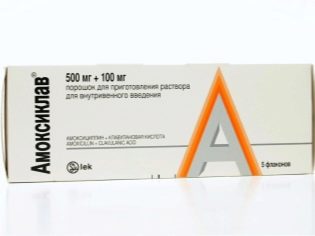Causes, treatment and effects of oligohydramnios during pregnancy
Every woman dreams of her pregnancy proceeding easily and naturally, so that no one and nothing can distract the future mother from pleasant thoughts about the future child. However, in reality, not everything is so smooth.
One of the serious complications may be lack of water. That it is and how to treat it, we will tell in this article.
What it is?
In a broad sense, low-flow water refers to a decrease in the amount of amniotic fluid from the norms characteristic of a given gestational age. However, in the classical understanding of this word, low amount of water is considered a small amount of amniotic fluid on the eve of childbirth, at about 39-40 weeks.
When there was no ultrasound, and the amount of water could only be guessed, lack of water was really determined just before the birth. Now, thanks to the development of diagnostics, identify the tendency to a decrease in water in the fetal bladder can be already from week 16
Water is necessary for the normal development of the child. They are also the nature provided by the shock absorber, softening the shaking, swaying, which the baby could feel quite significantly when walking or other actions of a pregnant woman, if the waters did not hinder this.
The amniotic fluid begins to develop at about 8 weeks of gestation, and with an increase in the period of gestation, it also increases in volume. In the 3rd trimester, there is some decrease in fluid, because the uterus is already greatly stretched by a raised child.
The long years of studying prenatal development have allowed physicians and scientists to calculate the normal amounts of amniotic fluid that are determined for each period. To measure them with standard for liquid measures - milliliters, for example, is not accepted.
To assess their number, there is a special parameter - the amniotic fluid index. It is possible to determine it in millimeters from the 16th week of the gestational period during the passage of an ultrasound scan.
Standards IAG - table:
|
Obstetric term (week) |
IAG (limits), mm |
Obstetric term (week) |
IAG (limits), mm |
|
16 |
73 -201 |
30 |
82-258 |
|
17 |
77-211 |
31 |
79-263 |
|
18 |
80-220 |
32 |
77-269 |
|
19 |
83-225 |
33 |
74-274 |
|
20 |
86-230 |
34 |
72-278 |
|
21 |
88-233 |
35 |
70-279 |
|
22 |
89-235 |
36 |
68-279 |
|
23 |
90-237 |
37 |
66-275 |
|
24 |
90-238 |
38 |
65-269 |
|
25 |
89-240 |
39 |
64-255 |
|
26 |
89-242 |
40 |
63-240 |
|
27 |
85-245 |
41 |
63-216 |
|
28 |
86-249 |
42 |
63-192 |
|
29 |
84-254 |
Since the amount of water in the fetal bladder is not constant, at different times one and the same expectant mother can find lack of water, and after a few weeks it is not detected. Such a natural phenomenon is called functional low water. This is the most harmless of all types of this complication.
Usually at the medical verdict of “shallow water” a woman falls into a stupor. The following official statistics of the Ministry of Health should reassure future moms:
- low water is accompanied by about 4% of all pregnancies;
- only 0.5-1.2% of such cases have pathological causes;
- all the other women (and the overwhelming majority) perfectly finish and give birth to healthy children, since their lack of water was physiological.
Malovodiem pathological is considered to be a persistent inadequate amount of amniotic fluid, which manages to register repeatedly for a variety of terms, starting from week 16.
Classification
Malovodie can be acute, if it suddenly appeared under the influence of negative factors, and can develop gradually and almost imperceptibly, and then it will be classified as chronic.
With acute water deficiency, the body of a pregnant woman can react to a viral illness, flu or ARVI, which the expectant mother could not protect herself from during the period of gestation. Such a violation is usually temporary and It does not mean that the baby has a pathology.
More dangerous chronic shallow water.It usually develops due to problems that can not be called quick fixes - mom's diabetes, obesity, as well as malformations of the child and his long-term hypoxia. Such a violation in itself does not pass, it necessarily needs treatment. Also, the violation may be early if it was revealed at the time between the 16th and 20th week and later, if the problem was found only after 26th week.
In the case of early water deficiency, the doctors' forecasts are less optimistic, because the process of the formation of the internal organs and systems of the baby is not yet complete.
Severe malnutrition at an early period may be an indicator of gross genetic abnormalities in a baby, and therefore such a “finding” on ultrasound requires detailed study using other diagnostic methods. In the later periods, the violation is often functional, quite natural, it is easily subject to correction or passes on its own.
Sometimes the development of such a disorder is affected by the membranes, or rather their integrity:
- if they are not changed, not injured, then doctors talk about primary lack of water;
- if the shells are damaged and the water is leaking, this is a secondary violation.
Primary malnutrition occurs in 80% of cases. According to the quantitative indicator of deviations from the norms indicated in the table, moderate and severe low-water levels are distinguished.
Wrong count oligohydramnios (this is the scientific name of oligohydramnios) an independent disease. This is a pathological condition during pregnancy, which is only a symptom of a true violation.
The reasons
The reasons for the decrease of the amniotic fluid, which are so important for the baby, are diverse. It can be malformations of the child, his disease, pathology of the placenta, as well as diseases of the expectant mother, both acute and chronic.
Some genetic, including chromosomal abnormalities that have arisen during the period of conception, in the formation of the genetic code, the karyotype of the fetus, occur precisely against the background of a decrease in the amount of amniotic fluid.
In particular, such defects as abnormal development of the urethra and its valves, as well as abnormal narrowing of the urethra of the baby or its absence, solidarity of the ureters or anomalies in their structure lead to the development of oligohydramnios.
Severe lack of water is observed in pregnant women if the baby has no kidneys as such due to the “mistake” of nature.
Polycystic kidney disease (Potter syndrome) is also a very obvious cause of pregnancy problems. Among the chromosomal abnormalities, water deficiency is most often accompanied by Down syndrome and Turner’s disease.
If the genetics of the baby is all right, and this was confirmed with the help of other diagnostic methods, then doctors consider the probability of infection of the fetus. The most dangerous in terms of risk oligohydramnion - cytomegalovirus infection and chlamydia. The backlog of water from the norms is often the case when fetal development is delayed.
The main maternal illness that can lead to oligohydramnios is gestosis. In addition, this condition can cause venous insufficiency, the tendency to form blood clots, diseases of the cardiovascular system.
Adversely affect the amount of water and kidney afflictions of the expectant mother, and diabetes. Dehydration can also cause a decrease in the amniotic fluid, as well as smoking, with which some of the expectant mothers, even in an “interesting position,” cannot say goodbye.
Pathology of the placenta - insufficiency, heart attacks of the “children's place”, any abnormalities in its development that occurred during the formation of this temporary organ at the very initial stages lead to lack of water.
Among other reasons that can lead to such an unpleasant complication of pregnancy is pereasivanie, in which there is a natural aging of the placenta, injury to the membranes of the membran of perimensional, the mother receiving a large number of medicines for a long time, as well as fetal death and multiple pregnancy.
Symptoms and signs
It is practically impossible for women to determine oligohydramnion in their own hands, this is the work of specialists. Only a few signs may indirectly indicate the likelihood of a decrease in the amount of amniotic fluid.
Usually in women with low water the size of the abdomen is smaller than it should be in time. To establish the violation becomes possible due to measurements of the height of the day of the uterus, which are carried out at each routine examination in the antenatal clinic.
When the expectant mother begins to feel the movements of her child, when there is little water, they can be quite painful for a woman.
Such sensations can not be silent, if the symptom has not been diagnosed earlier, you should definitely report your suspicions to the doctor, who will prescribe all the diagnostics that are necessary in this case.
Diagnostics
The amniotic fluid index is determined by the ultrasound doctor. It measures the distance free from the baby’s limbs and umbilical cord between the baby and the anterior abdominal wall, its inner surface. This measurement is called the vertical pocket.
If the result of measurements after a comparative analysis with the tables shows that the amount of water is reduced, the degree of violation is revealed. With moderate low water, the index is reduced by 10-15% compared to the above norm, and the vertical pocket, which, with a normal amount of water, is 5-8 cm, is reduced to a size less than 5 cm.
Expressed is a violation in which the vertical pocket does not exceed 2 cm, and the amniotic fluid index deviates from the norm by 15-20%. To imagine in more detail all of the above, we present a comparative table.
Violations of amniotic fluid:
|
Obstetric term, week |
Moderate low-flow - amniotic fluid index, mm |
Severe water deficiency - amniotic fluid index, mm |
|
16 |
62-84 |
62 |
|
17 |
65-89 |
65 |
|
18 |
68-92 |
68 |
|
19 |
71-95 |
71 |
|
20 |
73-99 |
73 |
|
21 |
75-101 |
75 |
|
22 |
76-102 |
76 |
|
23 |
76-103 |
76 |
|
24 |
76-103 |
76 |
|
25 |
76-102 |
76 |
|
26 |
76-102 |
76 |
|
27 |
72-98 |
72 |
|
28 |
73-99 |
73 |
|
29 |
71-97 |
71 |
|
30 |
70-94 |
70 |
|
31 |
67-91 |
67 |
|
32 |
65-89 |
65 |
|
33 |
63-85 |
63 |
|
34 |
61-83 |
61 |
|
35 |
59-81 |
59 |
|
36 |
58-78 |
58 |
|
37 |
56-76 |
56 |
|
38 |
55-75 |
55 |
|
39 |
54-74 |
54 |
|
40 |
54-72 |
54 |
|
41 |
54-72 |
54 |
|
42 |
54-71 |
54 |
If the ultrasound specialist indicates in conclusion that a woman has signs of moderate low flow, an obstetrician-gynecologist Be sure to send it to doplerometry and expert ultrasound, to more accurately know the condition of the child, the placenta and blood flow in the uterine vessels.
When the ultrasound protocol indicates that the pregnant woman has severe water shortage, she is hospitalized for a more thorough examination.
If the reason lies in the congenital pathologies of the baby, it is recommended to terminate the pregnancy for medical reasons. To agree or not, decide only the most pregnant. If she refuses, then the child is retained until the very birth, they provide him with the necessary drug support.
Possible consequences for the mother
A woman who suffers from water deficiency threatens to terminate a pregnancy in the later periods, traumatic both the psyche and the physical health of the reproductive system. If the child dies, there is no other option. After an interruption on a long term, a woman can have a nervous breakdown, develop secondary infertility.
A small amount of amniotic fluid aggravates the process of childbirth. Weakness in labor forces often develops, a woman is threatened with a Cesarean section. The postpartum period in such women is more severe, and complications are likely.
Pregnancy itself can deliver many unpleasant feelings to the expectant mother: the more the child becomes, the more difficult it is for the woman to withstand his movements.
The probability of miscarriage during pregnancy with low water is high, the risk of premature birth is even higher - it reaches 26%.
Possible consequences for the child
Babies born after pregnancy with shallow water have low weight, they are weaker than their peers, even if the pregnancy is before the expected date of birth.
The most severe consequences of long-term high water are various adhesions of the skin of the fetus and the membranes of the amniotic bladder. As a result of such adhesions, the free space of the uterus can fill the cords. They can entangle the baby.
Due to the pressure that the strands will exert on the fetal tissue, irreversible deformities are formed - the kids self-amputate or have severely curved limbs, there are defects in the face, chest. The appearance of the baby are completely disfigured. The frequency of such effects is small, but this can not be excluded.
The likelihood of such outcomes increases if oligohydroamnion is diagnosed early, at 16–20 weeks, and persists throughout pregnancy.
In childbirth, other troubles associated with a small amount of amniotic fluid may occur - loss of the umbilical cord, premature violation of the integrity of the amnion and, as a result, a long anhydrous period, which can turn into hypoxia and infection.
Many women mistakenly believe that lack of water is the cause of such illnesses as Down syndrome, as well as other chromosomal abnormalities. The logical connection here is of an opposite nature - in Down syndrome, oligohydramnios often develop, and not vice versa.
Almost always, prolonged oligohydramnion causes intrauterine growth retardation of the baby. It is dangerous in this case the underdevelopment of the lungs, with which the moms give birth to such babies.
However, if the help was given to the crumbs correctly and in a timely manner, then the child rather quickly then begins to gain weight and soon catches up with his peers in physical development. However, intellectually, the baby can develop for a long time late.
Dangerous cases of detection of water deficiency are also dangerous in terms of the likelihood of complications. 30 weeks pregnant, but only under the condition that the pathological condition persists for 4-6 weeks or more.
A regularity is characteristic of any negative consequences of low water for the child's health - the earlier this condition occurs, the more serious the consequences can be.
Treatment
The therapy of oligohydramnios is always comprehensive. And it begins with the determination of the exact cause that caused the pathological decrease in the amount of amniotic fluid.
Firstly checked version with chromosomal abnormalities. For this, a woman, depending on the period, is sent to one of the methods of invasive prenatal diagnosis.
With oligohydramnios detected at 16 weeks, a chorionic biopsy can be performed. If the fact of lack of water became known later, a woman can be sent to cordocentesis, amniocentesis.
These procedures will help to obtain amniotic fluid samples with parts of the baby’s epithelium, cord blood from the umbilical cord. An analysis will be carried out in the genetic laboratory that allows us to speak with a high degree of accuracy about the presence or absence of Down syndrome, Cornelia de Lange syndrome and other abnormalities associated with a violation of the number of chromosomes in the karyotype and causing lack of water. Such studies are usually conducted is free.
Recently, it has become possible to do a non-invasive prenatal DNA test, which is still costly. It is absolutely safe for the baby and is based on the isolation of the child's DNA from the venous blood of a pregnant woman. This test detects chromosomal abnormalities with a probability of 99.9% and is an ideal alternative to invasive tests that can be dangerous for both the pregnant woman and the fetus.
When confirming the cause of oligohydramnios due to chromosomal abnormalities, abortion is recommended.
If, further, the examination does not show the child that there are gross chromosomal abnormalities, then the experts of the expert class ultrasound will look for the defects of physical development. To do this, carefully examine the urinary system of the baby - ureters, urethra, kidneys. Particular attention will be paid to the health of the placenta. To assess the blood flow in the uterine vessels spend USDG.
The attending physician will send a woman to blood tests that can confirm or deny the presence of infections, including sexually transmitted infections.
Be sure to donate blood for sugar and urine for its protein content. The doctor monitors the blood pressure of the future mother, to eliminate preeclampsia as the cause of low water.
If the cause is found, doctors decide how to treat the underlying disease, almost all of them, except for congenital malformations of the fetus and chromosomal pathologies, are amenable to treatment. At the same time, control over the condition of the fetus is enhanced.
A moderate degree of oligohydramnios can be treated at home, in most cases, hospitalization is not requiredif the expectant mother will comply with all the recommendations of the doctor.
Severe lack of water, if it is detected at an early period, is also an indication for abortion, no one of the doctors will decide to make predictions about its outcome. In severe deficiency diagnosed after 26 weeks, the woman is hospitalized.
Drug treatment
The future mother with pronounced shallow water injected solutions of vitamins intramuscularly. In addition, she is given a dropper with drugs that improve uteroplacental blood flow. Usually used for this «Actovegin». Additionally, doctors recommend taking "Curantil"The dosage and frequency of this drug is determined by the doctor.
A broad-spectrum antibiotic can be prescribed to a pregnant woman to cope with the infection, if present. In the period of carrying a baby for these purposes, it is often recommended «Amoxiclav». To improve the metabolic processes in a woman’s body, drugs such as «Hofitol», as well as multivitamin complexes, designed and created specifically for pregnant women.
Simultaneously with the intake of drugs in the hospital every day or every other day the condition of the baby is checked. A woman is given CTG, if the pregnancy is already above 28 weeks, the functionality of the placenta is monitored with the help of USDG, ultrasound scanning can be performed at any time to assess the amount of water over time.
Any disturbing symptoms that can speak of the unhappiness of the fetus, at any time, may be the decisive reason for doctors to perform a Cesarean section ahead of time.
At moderate shallowness, which, according to the doctor, is of physiological origin, the woman is discharged "Curantil", "Actovegin» in pills and multivitamin preparations, she will have to come to the reception once a week, each reception will be accompanied by cardiotocography (CTG), until the doctor makes a diagnosis based on the normal values of the amniotic fluid index according to the results of additional ultrasound.
General recommendations
A woman with shallow water should be limited to physical activity. This recommendation applies to both outpatient and inpatient treatment. Any heavy loads are strictly contraindicated.
At the initial stage It is recommended to review the diet and drinking regime. Increasing the amount of fluid you drink, according to statistics, allows you to increase the amount of amniotic fluid by 20-25%.
Long walking, playing sports with such a complicated pregnancy are undesirable. Additionally have to limit sex. Pregnant overweight, obesity is recommended to go on a special diet in order to exclude an even greater weight gain.
Nutrition with oligohydramnios should include a large amount of fruits and vegetables, proteins and fats should be balanced, and fast carbohydrates (sweets and pastries) should be completely abandoned.
If there are swelling, you should consult with your doctor, together to work out the correct and adequate drinking regime. With preeclampsia and hypertension, it is important to measure arterial blood pressure twice a day. With a significant increase in it, a woman needs qualified medical assistance.
Traditional methods of treatment
Alternative medicine is ready to offer pregnant women with moderate shallow water a lot of useful and enjoyable recipes and products that, if they do not increase the amount of water, they will be able to meet the needs of the future mother with deficient amniotic fluid in essential minerals and vitamins.
Folk remedies should not even try to treat low-flow severe degree. But with minor deviations from the norm, a woman may well use some advice if her doctor has nothing against it.
The mineral requirements for oligohydramnio help restore figs, melon and grapes. Also good, according to reviews of future mothers, zucchini and fresh tomatoes help.
A real storehouse, a natural “pharmacy” for a pregnant woman with a deficiency of amniotic fluid, can be black ashberry A woman can take 50 grams of juice per day or about 100 grams of berries per day.
Another favorite remedy for shallow water - strawberries. They are eaten fresh or brewed with homemade fruit juice with them in order to improve the normal functioning of the kidneys. If the pregnancy fell in the winter and strawberries have nowhere to take, you can drink a weak tea with strawberry jam. If this is not in stock, it can be purchased.
Prevention
Avoid low birth during pregnancy will help the proper and responsible planning of the child. A woman should be examined in advance by doctors of different specialties.who will be able to answer questions about her state of health and the presence or absence of chronic diseases.
Of course, it is not necessary to conduct a full medical examination, but a woman who dreams of a child has to visit a cardiologist, a therapist and a nephrologist. Visits to these specialists will help to ensure that the heart, kidneys, and general health will help the woman carry the baby without complications.
If the age of the future mother exceeds 35 years, it is worth consulting with a geneticist, because the probability of conceiving and having a child with Down syndrome or Patau increases in proportion to the age of the mother.
It will be correct to make tests for sex and other infections even before conception, and, if something like this is found, to treat them before the child is conceived.
Quit smoking should be before conception, as a last resort, as soon as it becomes known about the pregnancy. Smoking, and this has been proven, very often acts as a provocative factor of oligohydramnios.
During pregnancy for preventive purposes It is important not to refuse to undergo mandatory screening studies. in the first, second and third trimester, do not abandon the ultrasound and the delivery of those or other doctor-recommended tests.
Expectant mothers should be protected from viral infections, especially during periods of massive incidence of ARVI and flu, in order to avoid the development of low water after illness. To do this, you should refrain from visiting shopping centers and public transport during seasonal epidemics, follow the rules of personal hygiene.
If the doctor insists on hospitalization, you should not give up on her, even if the woman herself feels that she is feeling fine, and she has absolutely no time to stay in the hospital.
Reviews
In most cases, according to reviews of pregnant women left on the Internet, pregnancy with low water has ended quite well, the children appeared on time or a few days earlier, weighing from 3 to 3.5 kilograms.
Sometimes there are stories about diagnoses practically incongruous with each other, when an ultrasound scan gives a woman both low water and a large fetus. Almost all such cases ended with a planned caesarean section.
In some cases, doctors had to resort to the stimulation of labor activity with medicines or to make a cesarean section.
Many pregnant women complain about the ambiguity of the estimates and criteria for violation. In one consultation, they are diagnosed, and in another or in a paid clinic, ultrasound scanning says that the amount of water corresponds to the lower limit of the norm, and therefore no treatment is required.
Indeed, the approaches and devices are different everywhere, and a difference of 2-3 millimeters can give a woman a lot of feelings even when there is no reason for them.
For more information about the causes, treatment and consequences of low water, see the next video.
